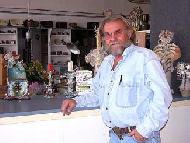Eric Abraham
Marriages
Judy Love
Ruth DeOreo
Obituaries
Vail Daily page A2 - September 18, 2013
VAIL — One of the original characters of Vail’s art scene has gone to that great gallery in the sky.
Eric Abraham died Sept. 7 due to complications following colon cancer surgery. He was 76.
Abraham was once asked why he’s an artist. He rattled off a list of professions for which he’s unfit.
“People took me skiing one time as a joke. So, I couldn’t become a ski instructor.
“I’m not going to lie, so I can’t be a politician.
“I was interested in being a stock broker, but handling other people’s money is too much responsibility.
“Art,” Abraham concluded, “is the easiest thing I could do.”
His signature was “Eric Abraham, WFA,” for “world famous artist.” His art lives in a world where pigs in hats fly and robots drink martinis.
Abraham’s sculptures tend toward whimsical complexity. Pay attention or you might miss the joke, like his fairy tale-inspired mirror called “Did Humpty Fall Or Was He Pushed? Only the King’s Men Know.”
“Other potters do the straight stuff much better than I can, so I’ll let them do it,” Abraham said. “There’s that old saying: ‘A pot without a soul is just clay around a hole.”
Local artist Randy Milhoan met Abraham at the University of Nebraska in 1964.
When Milhoan was helping launch the SummerVail art workshops in 1971, he turned to his old friend. Abraham was paid a whopping $125 a week, plus free food and board, to come teach for the summer. He did it for 12 consecutive summers.
Abraham moved to Vail in 1974 and taught ceramics at Colorado Mountain College in Vail and Leadville. You learn all kinds of things about people, like the time Milhoan and Abraham were painting some very large posters and Abraham confided that he was colorblind, which Milhoan said was pretty remarkable for an artist.
“Eric’s work has been remarkably identifiable in the 50 years I have known him,” Milhoan said.
Abraham’s work ethic pushed him to produce an enormous body of work, thousands of drawings, sculptures and inventive ceramics, Milhoan said.
“He accomplished one of the hardest tricks in life, making a living as a full time artist, while holding fast and true to his vision,” Milhoan said.
He always managed to make a living and handled everything himself. Now that he’s gone, he’s making pretty good money. Collectors have been beating path to the studio door in Lucas, Kan., trying to snap up some of Abraham’s work.
Writers and talkers have a verbal vocabulary. Artists have a visual vocabulary, says artist and Karats owner Dan Telleen. Abraham had a unique style that Telleen calls Baroque Funk.
“He was most successful selling his work at art fairs. He loved to talk to people and meet new friends,” Telleen said.
Abraham always wanted to build a roadside attraction, so he bought an abandoned car dealership building in Lucas. The people of Lucas were happy to have him in town, the community where S.P. Dinsmoor built his Garden of Eden of concrete sculptures in the early 1900s.
“Lucas was the perfect place for him to land. He had such a great imagination and he had that folk art mindset,” said gallery owner Jim Cotter, who hosted several shows for Abraham.
Abraham dubbed the 6,000-square-foot former Chevy dealership the “Flying Pig Studio,” in keeping with his propensity for slipping a flying pig into his artwork. In his biography he called himself the “world renowned professional professor of porkelain proficiency.”
The van in which he hauled artwork to shows was dubbed the “PigMobile.”
The former showroom was Abraham’s gallery, he did his business in the offices and his kiln and studio were in the back. He also had dozens of 1940s and ’50s vintage radios and lots of old cars in the back. His National Geographic magazine collection was complete back to 1915.
Remember how Lucas made national news a few years ago when it built and opened one of the largest public toilets in the nation? It was Abraham’s idea to have a puppy dog drinking out of the toilet.
He once tried to work a 9-to5 job for Hallmark, the greeting card company. It required a necktie. The good news is that he didn’t hang himself, or anyone else.
“He had an incredible work ethic and was constantly creating art,” Telleen said.
Telleen once asked him one of those where-do-you-get-your-ideas questions. Abraham retorted, “I just make stuff Dan. I don’t think that much about it. I just keeping making stuff.”
The national spotlight settled on him when he created two large, fire-breathing dragons. One was featured on NBC’s “Today” show.
Abraham was born Nov. 27, 1936, in Harlem to parents who were Works Progress Administration artists and writers in New York. His parents illustrated children’s books for the public schools of New York City, according to his website, www.ericabraham.net.
After his honorable discharge from U.S. Air Force Intelligence, he earned a Bachelor of Fine Arts in painting from the Kansas City Art Institute and his Master of Fine Arts in ceramics from the University of Nebraska.
He taught ceramics in the early 1970s at Kansas State, and then later again at several other universities before striking out on his own.
His works of art are currently on display at the Strecker Nelson Art Gallery in Manhattan, Kan., as well as the Courtyard Gallery in Lindsborg, Kan.
Eric is survived by his partner, Ruth DeOreo; friend and former wife, Judy Love; children Mercedes Abraham, Francis and Toni DeOreo, Marco DeOreo and Cynthia Redecker; and four grandchildren.
Donations may be made to the Kansas City Art Institute Student Scholarship Fund or the Grassroots Art Center in Lucas, Kan.
Staff Writer Randy Wyrick can be reached at 970-748-2935 and rwyrick@vaildaily.com.






